Visiting Yellowstone National Park in October is an unforgettable experience with benefits like reduced crowds and lower lodging occupancy rates, but it’s also very late in the season and that might just throw a few curve balls at your plans. We know from first hand experience the challenges involved with planning a trip to Yellowstone in the fall and we want you to be fully prepared for all eventualities.
If you’re a serial planner like we are, we recommend taking a look at our popular Yellowstone travel guidebook which helps with planning every aspect of your trip. But for now in this guide, we explain the 10 key things you need to know about visiting Yellowstone National Park in October, based on our experiences.
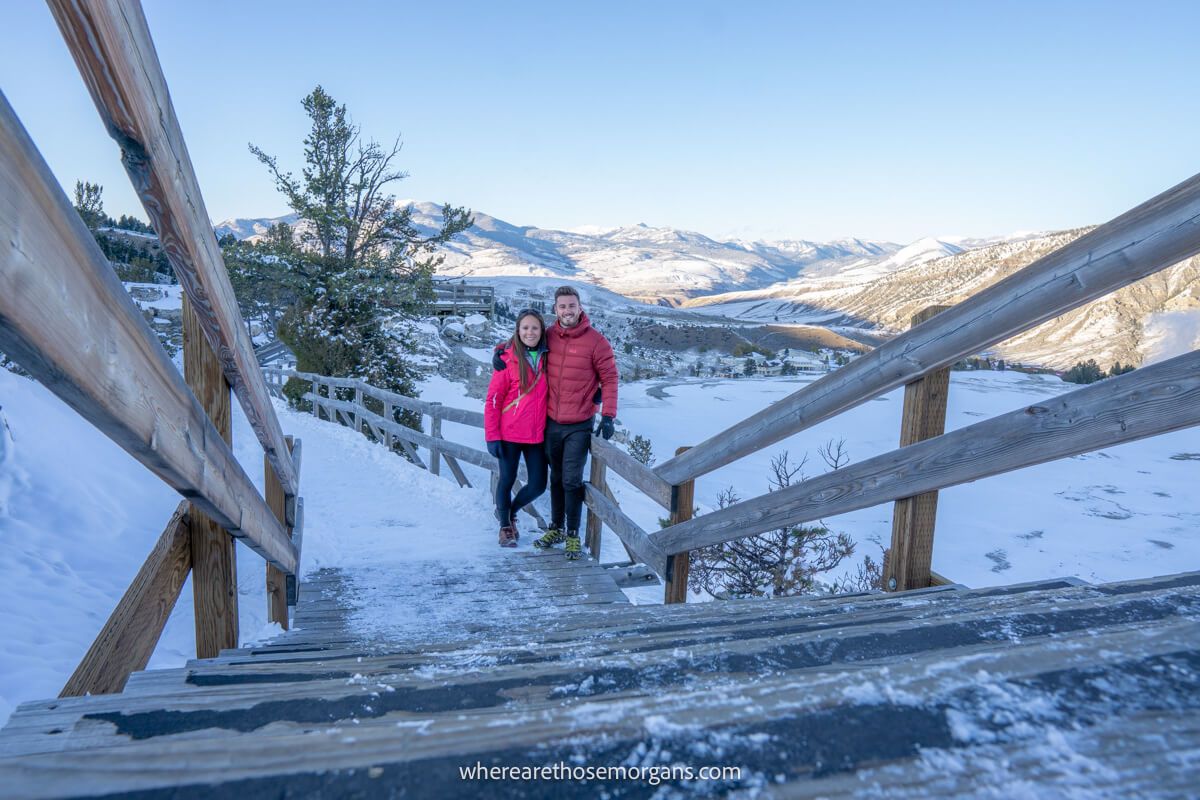
The very first time we visited Yellowstone was back in October 2019. After spending time in South Dakota, we drove the awesome Mt Rushmore to Yellowstone road trip route and planned to enter via east entrance from Cody WY. However, an overnight blizzard closed the east entrance so we had to drive up through Cooke City to enter via northeast entrance instead.
Despite the blizzard, we adapted our itinerary to suit beginning in Lamar Valley and we ended up having an amazing experience because the park was so quiet and we were able to book last minute into lodges around Mammoth and Canyon. It was freezing cold in the mornings and evenings, but that was a trade off we were happy to take for the distinct lack of crowds. Read more about us.
Note: This article may contain affiliate links. If you make a purchase using one of these affiliate links, we may earn a small commission at no extra cost to you. Thank you!
1. Crowds
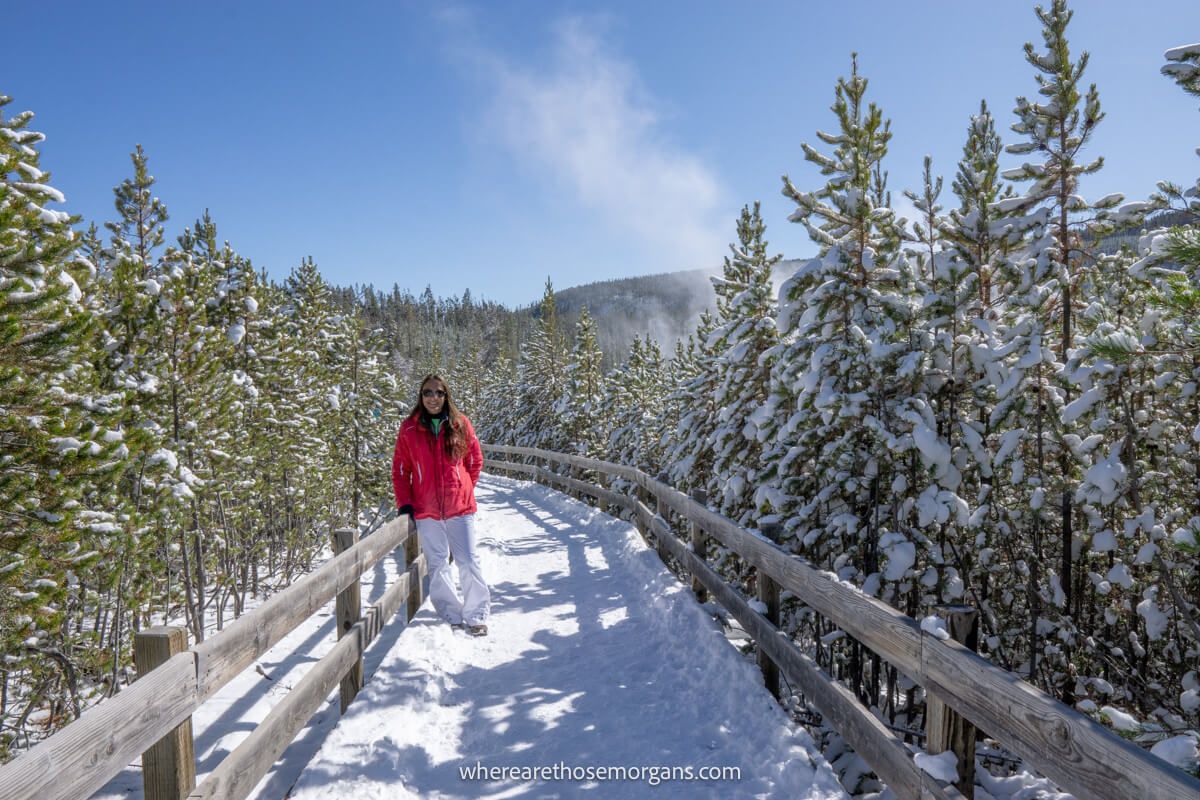
Yellowstone is consistently in the top 5 most visited US national parks each year. It typically receives around 4 million tourists annually, which is an enormous amount of people sharing attractions and cars sharing the Yellowstone Grand Loop Road.
Okay, let’s do a bit of math: If you divide 4 million by 12 months you get 333,333 people per month, or roughly 11,000 per day. Sounds like you’ll be sharing the park with a lot of other people, right?
Well, more than 2 million visitors to Yellowstone arrive in June, July and August alone. Those 3 months account for well over 50% of total visits each year, so October actually has a significantly lower amount of daily visitors.
Here are the visitor numbers broken down by month for 2016-2019:
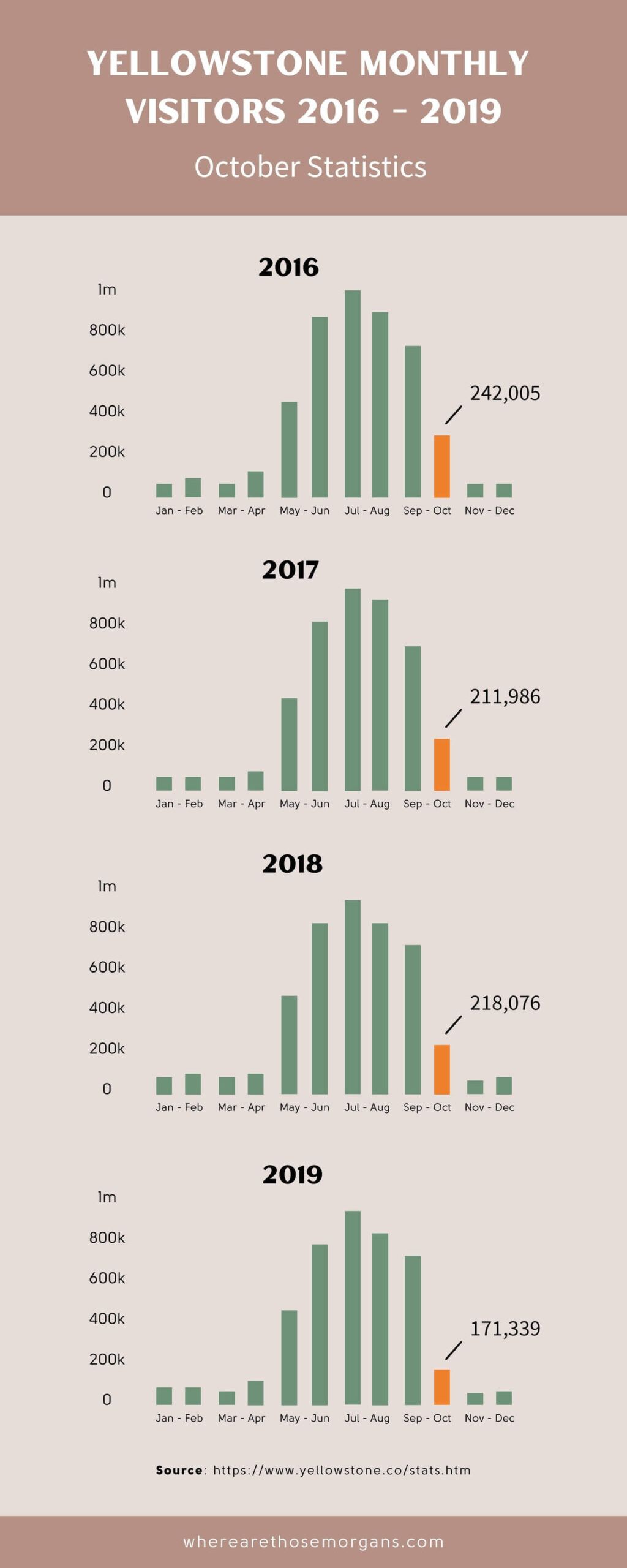
As you can see in the infographic we created above, October is the month of real transition in crowd numbers between summer and fall at Yellowstone. And although these years are outdated now, what’s important is looking at the trend as tourism numbers plummet from September into October.
Visitor numbers to Yellowstone National Park in October were as follows:
- 2016 – 242,005
- 2017 – 211,986
- 2018 – 218,076
- 2019 – 171,339
In October 2019, Yellowstone only welcomed 171,339 tourists for the entire month. Now, trust us when we saw that a daily total of 5,527 people is pretty sparse for a park the size of Yellowstone.
Let’s compare that number to July, which is consistently the busiest month at Yellowstone National Park with around 1 million visitors each year. In July 2019, a total of 936,062 people visited the park. That makes for a daily average of 30,196 tourists, which is almost 5 and a half times more than October in the same year.
What about more recent years? Well, according to Statista, 3.81 million visited Yellowstone in 2020, 4.86 million visited in 2021, 3.29 million visited in 2022 and a whopping 4.5 million visited in 2023.
These numbers show a clear pattern between lockdowns, domestic travel only, lockdowns being lifted resulting in greater international travel and finally a surge in domestic travel once again. See more data and sourced statistics.
How Does Fewer Crowds Benefit You?
- You stand a much better chance of booking into a hotel, cabin or campground inside the park.
- Booking hotels. last minute isn’t completely out of the question
- In summer, you can expect to see anywhere between 70-100 thousand visitors per month just from tour buses. We saw a grand total of 1 tour bus in October.
- There won’t be long lines each morning at the park entrances.
- Hiking trails will be empty and you will have better wildlife spotting opportunities.
- Photography will be much easier at the star attractions.
- The roads won’t be backed up every time you try to get anywhere and there will be parking spaces at geyser basins.
If our top priority was to avoid huge crowds of tourists, while still benefiting from reasonable temperatures and the park being completely open we would visit Yellowstone in late May or early October.
The take home message is that crowds will play a big role in how much you enjoy your first time vacation to Yellowstone. After we’d been once and understood the park’s layout, it was easier for us to imagine visiting with greater or fewer crowds.
2. Weather
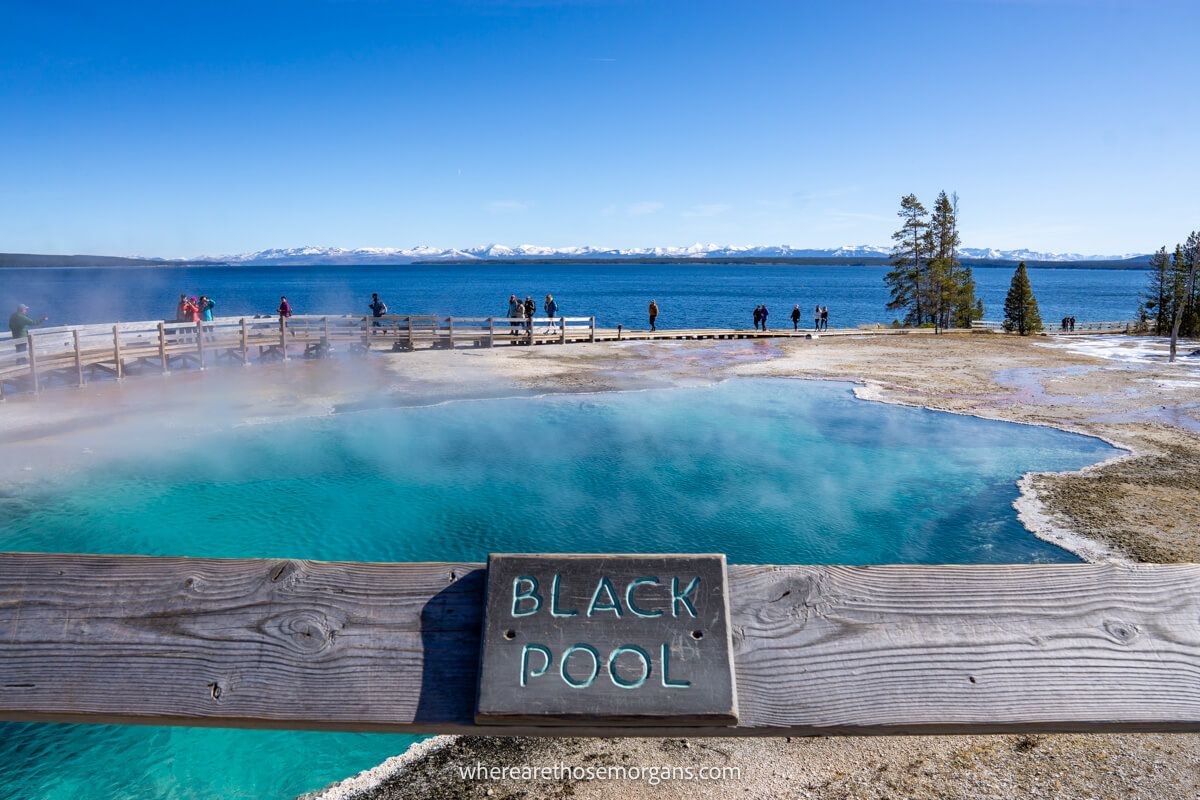
We typically recommend visiting most US National Parks in April, May, September or October because the shoulder seasons are much quieter than summer months. But Yellowstone is in northwest Wyoming and in October the weather can be extreme or entirely unpredictable. We had snow, fog, freezing temperatures and sun during our trip.
Here’s what you can expect on October 1st:
- High – 57 F
- Low – 31 F
- Snowfall – 1.2 inches
Here’s what you can expect on October 31st:
- High – 42 F
- Low – 23 F
- Snowfall – 5.1 inches
You can see there’s a dramatic change in average high and low temperatures from the start to the end of October. A low of 31 F isn’t so bad, but 23 F is starting to get very cold. And the average snowfall increases rapidly throughout October.
So you need to think carefully about whether you’re happy to plan your trip with these weather conditions. It’s also important to always keep a close eye on live Yellowstone weather reports in the days leading up to your visit, as well as during each day you’re in the park.
Now, the changeable weather is both good and bad. On one hand it keeps the hordes of tourists at bay but on the other hand it can impact your plans with things like road closures, hiking trails closing and even your safety.
It never got above freezing during the 4 days we spent inside Yellowstone National Park in October. This meant mornings and evenings were dangerously cold to be out taking photographs but we had full ski gear on.
If you visited Yellowstone in summer, the likelihood would be warm sunny days and occasional cloud or rain showers. But in October, anything can happen. You could get lucky with clear blue skies but you could also end up having to scramble and adapt your Yellowstone itinerary last minute like we did.
Our Negative Experience With Weather
As we mentioned earlier, an almighty overnight snow dumping put the brakes on us entering the park. All roads in, out and around Yellowstone closed for a day, except north entrance at Mammoth. So people in southern areas of the park like Old Faithful and central parts like Canyon couldn’t leave the park. And of course, we couldn’t get in. So we spent a day in Cody.
Fortunately, our hotel bookings inside the park were automatically moved back by one night so we didn’t lose any money. But instead of entering via east entrance the next day because it was still closed, we had to drive north and west over WY-296 (which turned out to be incredibly scenic) to enter the park via northeast entrance a day later than planned.
The extra 4 hours of driving didn’t concern us but we had to drive through Lamar Valley at lunch time. Lamar Valley is the best place to see wildlife in Yellowstone and midday is the worst time for animal activity. So we were pretty bummed but we didn’t want to completely rewrite our entire itinerary just for that one spot in the park.
And that same downpour of heavy snow also resulted in the seasonal closure of the road between Tower-Roosevelt and Canyon, which meant the Mt Washburn hike wasn’t accessible. Again, that was disappointing for us, and we had to adjust our plans accordingly.
With all that said, seeing Yellowstone covered in a blanket of brilliant white snow was a truly magical experience. We felt fortunate to see both sun and snow in the park. Trees were stark and frozen solid, and colorful hot springs were contrasting against the white snow. It was like a winter wonderland with eerie steam and dense fog creating a surreal but beautiful environment.
3. Logistics
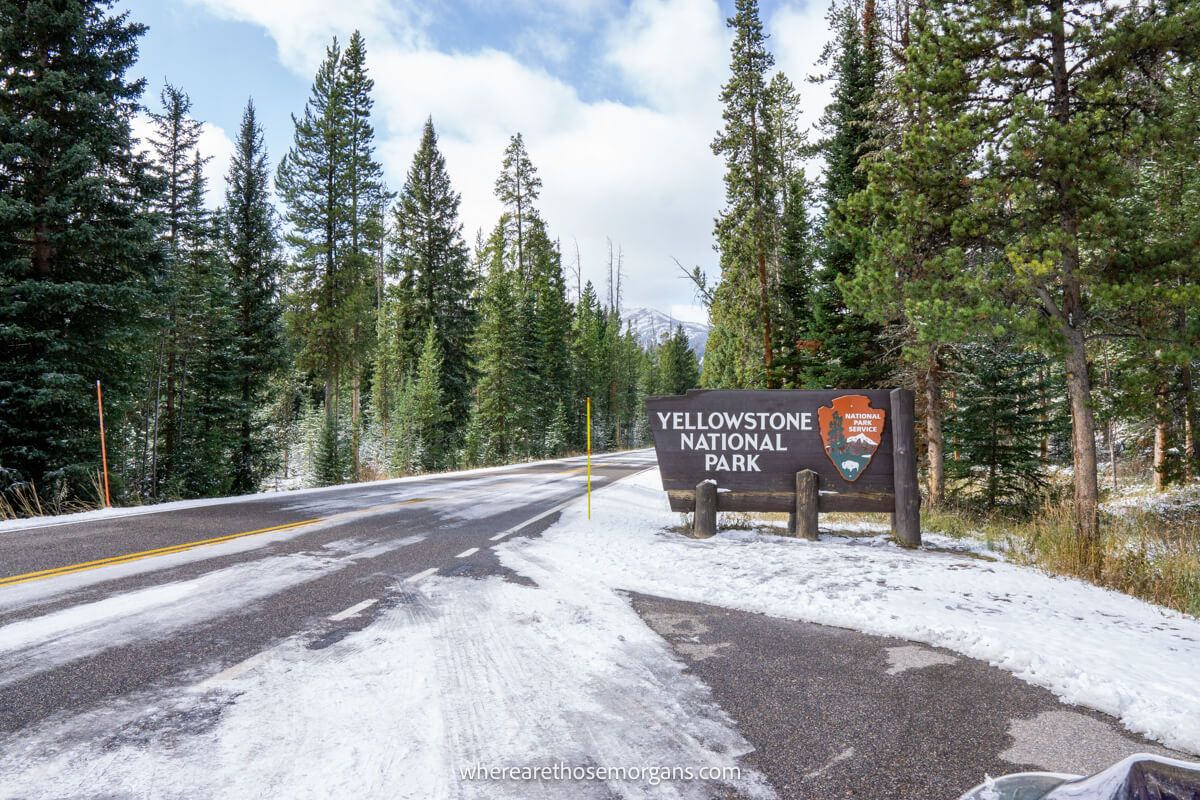
Potentially adverse weather conditions naturally leads us into travel logistics for your trip. Firstly, roads into and out from the park closing due to snow could cause issues getting to or from any of the airports near Yellowstone. It’s unlikely, but possible.
The bigger concern is roads inside the park connecting attractions like Old Faithful and Grand Canyon of the Yellowstone. They typically close internal roads on different dates each year, but it’s usually around the very end of October or beginning of November. If there’s a huge snow dump like we had before the end of October, one or two internal roads could close.
We don’t want to put you off by making it sound dramatic, we just want you to be aware of the risks. The trade off is that if the weather plays nicely instead, you’ll benefit from the freedom of Yellowstone’s Loop Road and you’ll easily be able to park at all attractions without any fuss.
What Can You Do To Prepare?
- Keep abreast of the current road status report for Yellowstone. This also shows ongoing national park projects which can keep certain areas closed (not just in October but all year in some instances).
- Add a day or two of fudge time around your itinerary in case you can’t get in our out of the park.
- Read our detailed guides on how to plan a road trip and how to pack for a road trip.
- Have a backup plan for entering the park. For example, south entrance closes, so you instead enter via west entrance.
Need help planning your trip to Yellowstone?
Our popular Yellowstone travel guidebook helps you with planning every aspect of your visit, including what to see in each region, where to eat and stay, itinerary ideas and map!
View Guidebook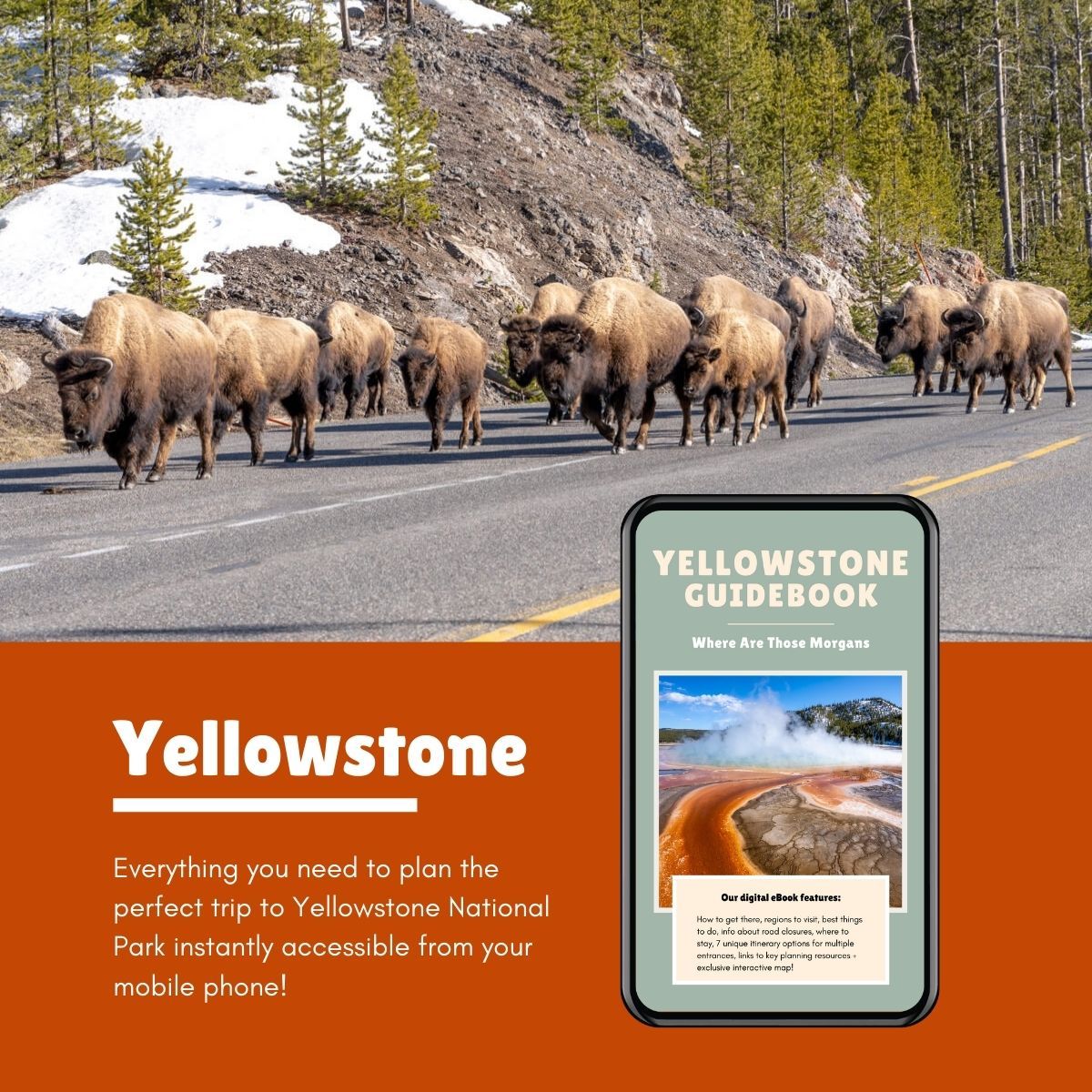
4. Hotels
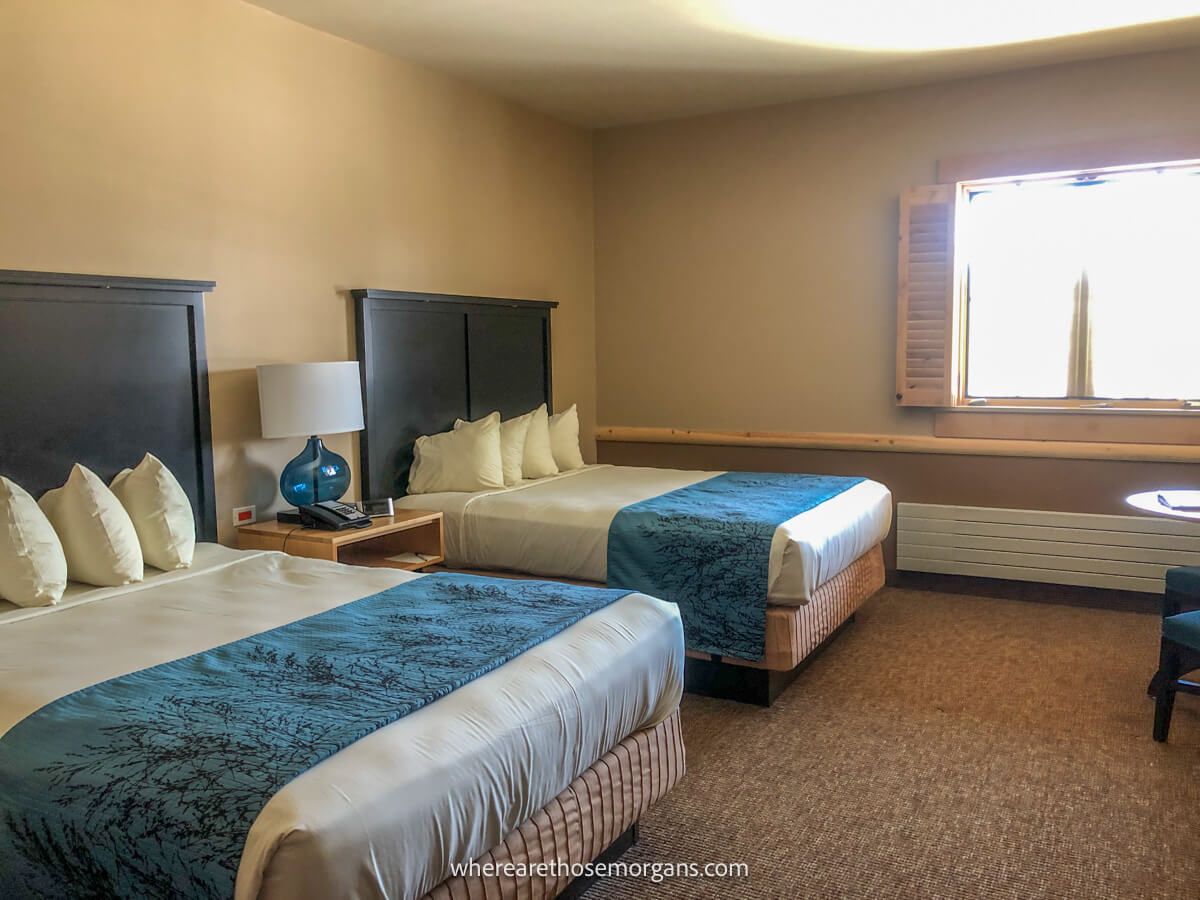
All being well with the aforementioned weather and logistics, visiting Yellowstone National Park in October has some serious benefits, which includes lower hotel occupancy rates and more affordable prices. You’ll have more choice over Yellowstone’s lodging options both inside the park and at hotels in resort towns like Gardiner and West Yellowstone.
Getting booked into national park hotels is notoriously difficult for the majority of the year and Yellowstone is one of the worst examples of having to book a lot of months in advance. But at the beginning of October right before Yellowstone closes for its winter season, there are usually some rooms free even if you book last minute. We know because we did it ourselves.
If you left things late in summer you’d have absolutely no chance getting a hotel room within Yellowstone’s boundaries so you’d have to leave each day to stay somewhere outside the park.
However, this comes with a very important notice:
Most Yellowstone hotels close around October 11th each year. So if you’re planning a late October visit, you have very limited options inside the park which can affect your itinerary. But hotels outside the park in Gardiner and West Yellowstone will still be open.
When Do Yellowstone Hotels Close?
- Canyon Village – All lodges and cabins close mid-October (Canyon campground closes in Sept)
- Madison – Campground closes mid-October
- Mammoth – Campground open all year, cabins close Sept but hotel open until late November
- Inn at Old Faithful – Hotel closes mid-October
- Lodge and Cabins at Old Faithful – Cabins close mid-October
- Snow Lodge at Old Faithful – Hotel and cabins close mid-October
- Grant Village Lodge – Hotel closes early October
- Lewis Lake – Campground open until early November
Keep in mind these closing times will slightly differ each year. So it’s important to check this list of all lodging opening and closing dates for your visit. Mammoth Hotel is your best bet for accommodation inside Yellowstone if you’ll be visiting mid to late October, but you should still book ahead of time to guarantee a room if you know your dates.
5. Fall Colors
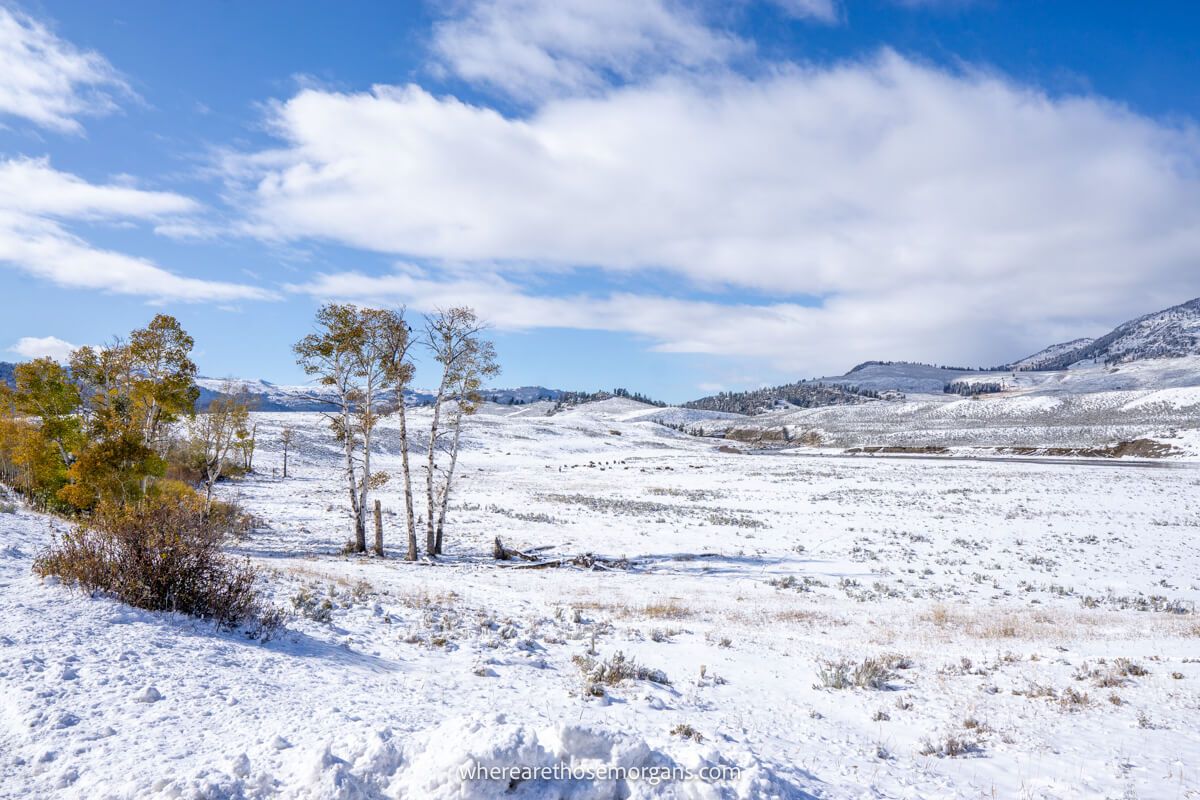
If you time it just right in the last week of September or the first week of October, you might just see the northern areas of Yellowstone glowing with golden yellows. No, you won’t get those postcard-perfect fiery reds, earthy browns and burnt oranges like you’d get on the east coast, but golden yellows alone would be more than enough to amplify Yellowstone’s natural beauty.
The day before we were snowed in at our hotel in Cody, the entire grassy landscape around town was a deep yellowy-orange color. Then the snow came and temperatures stayed below zero, so we missed out on seeing fall colors in Yellowstone by one day. Sure, frozen snow on the ground was awesome, but we love fall colors, so it was definitely a little frustrating!
A few weeks later we saw Yosemite Valley lit up with the same golden yellows and it was gorgeous, so we imagine Yellowstone would be similar. If you visit Yellowstone in the first week of October, we recommend visiting areas like Mammoth Hot Springs and Lamar Valley in the north, or driving south beyond Lewis Lake to Grand Teton National Park which will be even more beautiful with colors.
6. Wildlife
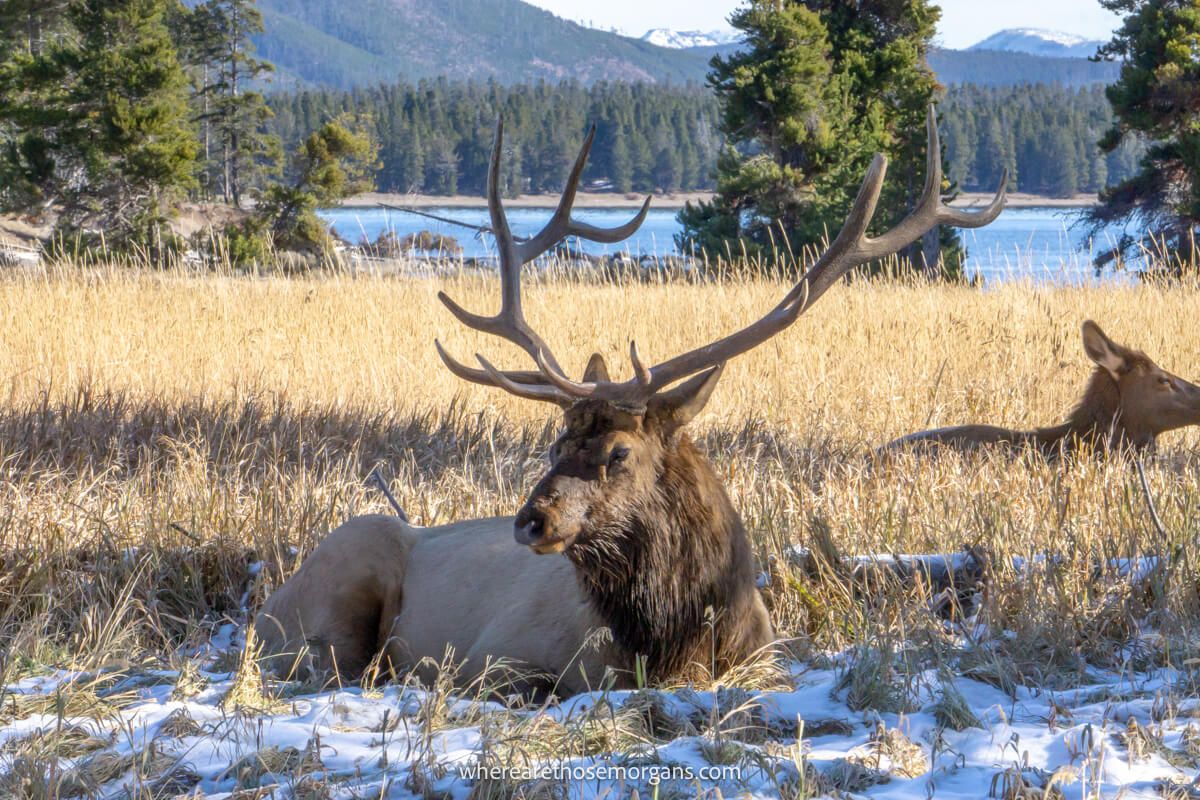
The fall is a fantastic time to see wildlife roaming freely throughout Yellowstone. Lots of animals are preparing to hibernate for the winter season, and with fewer cars and people around they’re a little happier to venture closer to roads and built up areas. Imagine how much distance animals will keep in summer when the park is overflowing with an enormous amount of people and cars.
Elk – Autumn brings out the best of elk viewing in Yellowstone because they enter breeding season, which is called the rut. This means you not only get to see them migrate from higher elevations to lower ground, but you’ll also enjoy listening to male elk bugling as they vie for female attention.
Bears – Both black bears and grizzly bears are preparing for hibernation season which typically begins in November. You might see them on the hunt for nuts to keep in their dens over the harsh winter period, just note you’ll likely need binoculars or a telephoto lens for your camera if you want to see bears in the wild.
Bison – You’ll quickly realize bison are much easier to see at Yellowstone than most other animals. They tend to have a nonchalant approach to humans and cars, and you’ll likely see them walking through Mammoth Hot Springs. We even got caught up in one of those famous Yellowstone bison jams between Mammoth and Norris in April.
Wolves – Because elk are moving to lower ground it’s easier to spot wolves in October. We tracked a coyote pacing through the snow along the Yellowstone River in Hayden Valley when we visited in October. But it wasn’t until our April trip that we saw our first wolf near Grand Prismatic Spring. It was a lone wolf feeding on a carcass.
Lamar Valley and Hayden Valley are traditionally the best places to spot wildlife in Yellowstone. But the east entrance road is also a bit of a hidden gem area to try out. The best piece of advice we can give you is to get out early in the morning if you want to see more elusive animals. They’re more active at dawn and very few people or cars are out before sunrise.
Do’s And Do Not’s When Wildlife Spotting In Yellowstone
- Do not simply drive into Lamar and Hayden Valley and expect every animal in the park to walk by for your photographs.
- But do hike a mile or so away from the roads to increase your chances of seeing wildlife.
- Do not abandon your vehicle in the road if you see a few people with cameras or telescopes.
- Instead do safely pull completely off the road or into a nearby parking lot so you don’t block the main road.
- Do not go looking for animals.
- Rather do quietly wait for them to come to you.
- Do not approach any wildlife if they are close by, especially for selfies.
- Instead do watch quietly from your car and enjoy photographing animals in their natural habitat.
7. Hiking
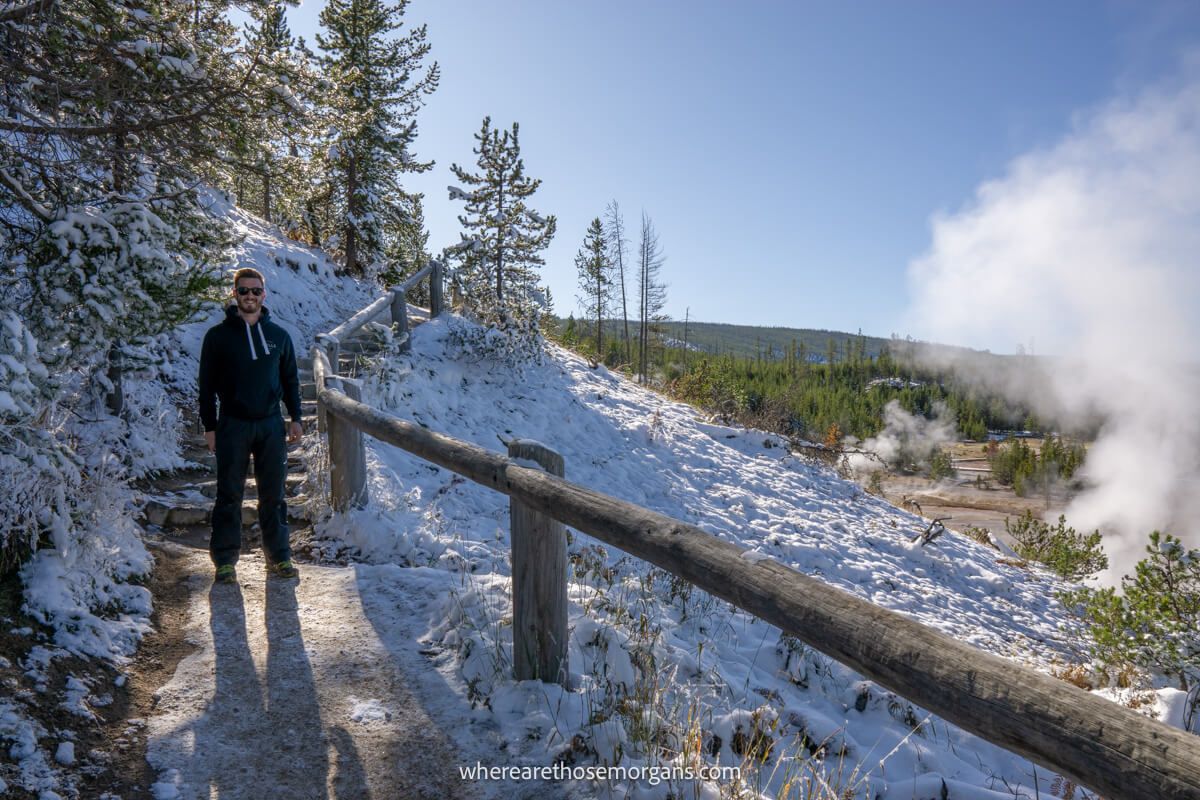
Hiking is one of our favorite things to do and it’s a huge part of this blog (see our hiking guides), but we haven’t actually done any major hikes in Yellowstone yet. Why? Because for us this is a place to casually walk around geyser basins taking photos of unique geothermal features, seeing waterfalls and watching wildlife.
In truth, there’s not a massive amount of notable trails in the park anyway. But if you are a big hiker and simply can’t miss the chance to hit some new trails, you’ll be equal parts thrilled and disappointed if you visit in October.
Positives: The trails are almost empty. With very low visitor numbers and just a fraction of those intending to hike, you can really escape and increase your chances of seeing wildlife. In summer the few hikes are much busier, so this really is a huge bonus for avid hikers in the fall.
Negatives: Due to the changeable weather, trails can close at any time. We think the hikes were open the day before we arrived, but the snow closed trailheads and roads leading to hikes. It’s also cold, so if the trails are open you’ll need to wear the right clothing and pack layers. Bears are also active, so increased activity in any given area could also close a trail.
If you only do one hike, Mount Washburn is the quintessential trail at Yellowstone. After that you should consider Fairy Falls, Mystic Falls or Avalanche Peak for stronger hikers. They will be peaceful as long as they’re open. You’ll stand a better chance of trails being open if you visit earlier in October, plus the scenery will be better because of the fall foliage colors.
It’s important you always keep on top of the current backcountry situation report for updates on trail closures, safety, animal activity and more. Finally, don’t forget your bear spray if you intend to hike into the backcountry and make sure you take everything back out of the wilderness with you.
8. Waterfalls
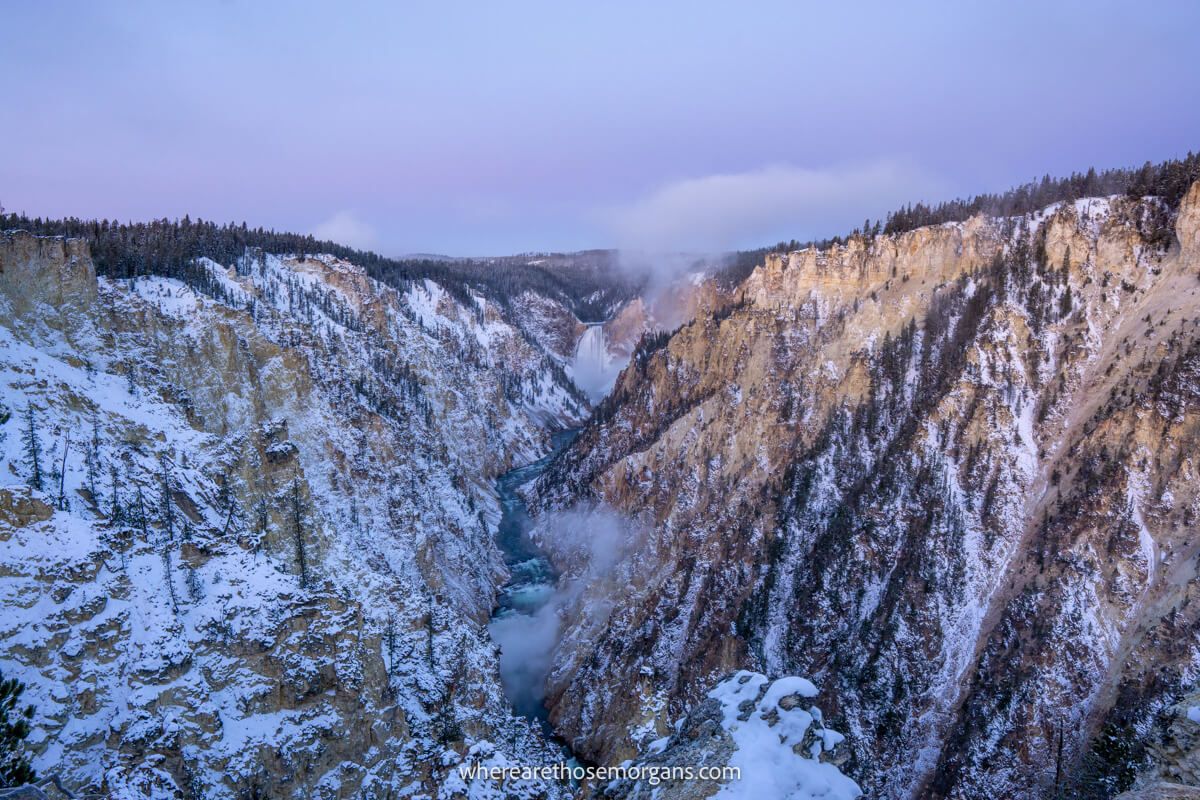
Autumn is typically the worst time of year to see waterfalls in the US because the volume of water is always so low. We found it to be more noticeable when we visited Yosemite in October because waterfalls are a star attraction and they dry up in the fall. But Yellowstone was actually a bit of an exception to the rule.
We were surprised to see the major waterfalls with high volumes of water, powerfully crashing down through the park’s rivers. Most notably of course is Lower Falls in the Grand Canyon of the Yellowstone, which is by far the most popular waterfall to see. We drove both rims flanking the canyon and enjoyed all the viewpoints just like it was spring or summer.
Now, the likes of Mystic Falls, Fairy Falls, Gibbon Falls and Firehole Falls won’t be as powerful as they might be in May or June, but you’ll be content as long as Upper Falls and Lower Falls are firing on all cylinders. The nearby Tower Fall is another great one to see, as long as the road between Canyon and Tower is open in October.
Our top tip is to photograph Lower Falls from Artists Point at the end of South Rim Drive for sunrise. This was one of our favorite Yellowstone experiences. It was freezing cold and icy on the ground, but we shared the serene sunrise with a few other enthusiastic (or foolish?!) photographers which was great.
9. Geysers + Hot Springs
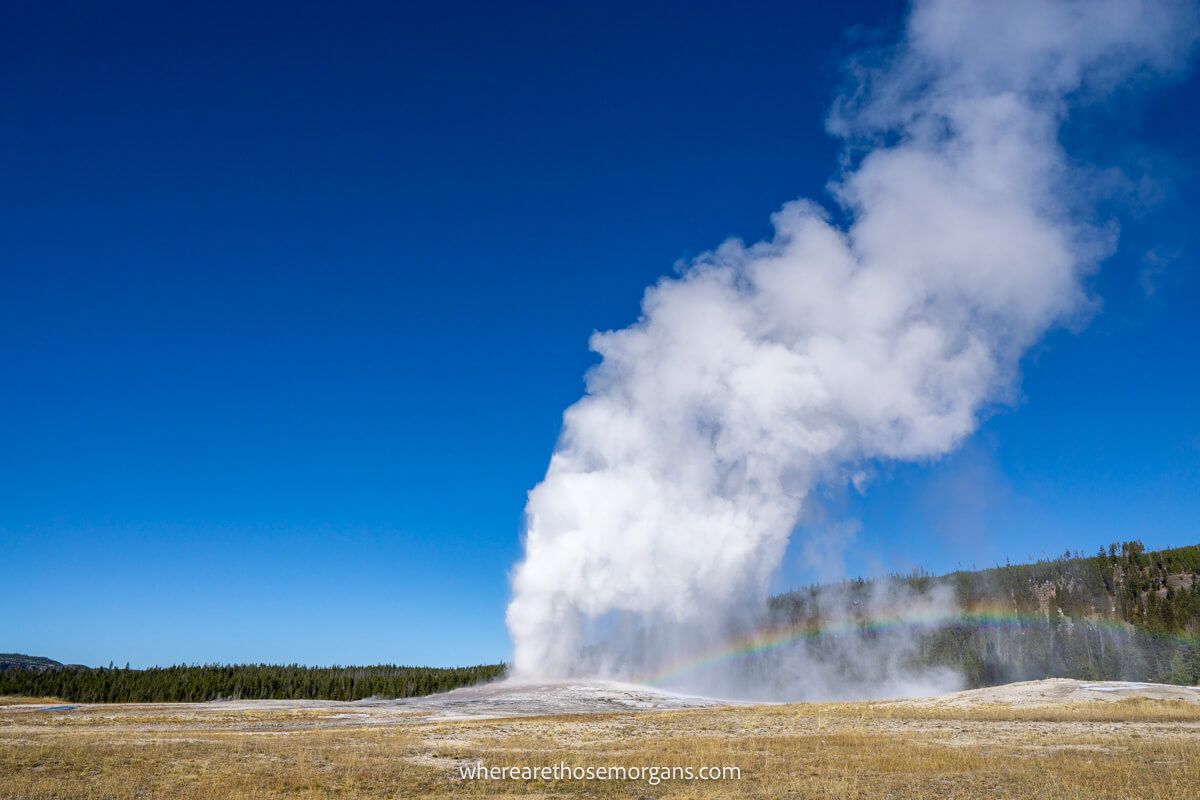
Yellowstone is famous and unique for its geothermal features like billowing geysers, vibrant hot springs and bubbling mud pots. In our opinion, exploring the geyser basins is among the truly unmissable things to do in Yellowstone on a first visit, so make sure you prioritize them.
However, the time of year does matter if you want to see them in all their pomp and glory. The cold October air clashes with scalding hot ground water which results in lots more steam than usual, so most geysers and hot springs are less clear than they would be under warmer summer air temperatures.
Have you seen photos of Grand Prismatic Spring with incredibly bright colors in a huge circular shape? Well, they were not taken in October. It’s more likely they were taken on a warm and sunny day in the middle of summer. When we visited Yellowstone National Park in October, Grand Prismatic Spring was vibrant but it was heavily shrouded in billowing steam and a layer of snow.
On a brighter note, Old Faithful was completely unaffected because it still erupted like it normally would. The trusty geyser blows almost right on schedule all day, every day and the season you visit will not impact on how much you enjoy the show. Many other geysers and hot springs in the basins will be slightly less impressive, but the trade off is that you’ll have them all to yourself.
Travel Tip: Steamboat Geyser, Echinus Geyser, Artists Paint Pots, Turquoise Pool and most of West Thumb basin are some of our favorite lesser known geothermal features to include in your itinerary.
10. Photography
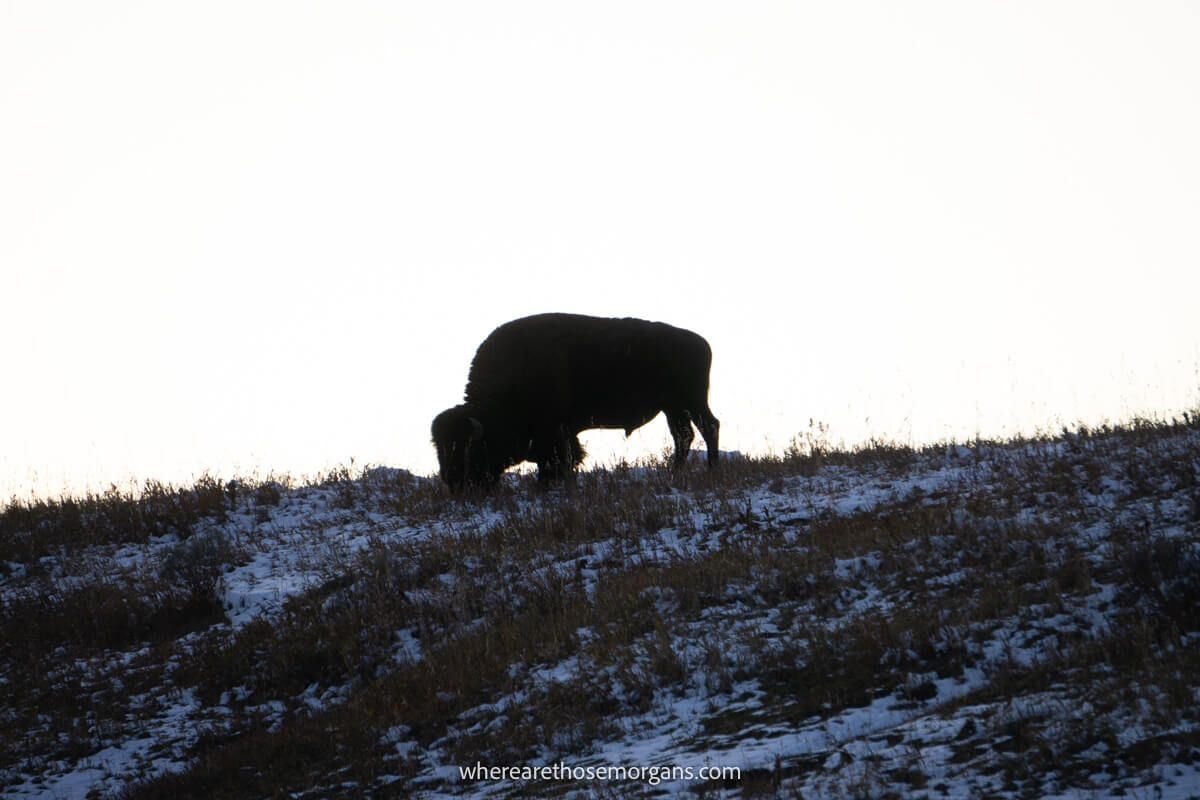
Both Yellowstone and nearby Grand Teton are incredibly popular landscape photography destinations for hobbyists and pros. We’ve been traveling the world since 2018 and we’ve been to lots of amazing places, but some of our all-time favorite travel photos are from these two parks. And it’s astonishing how different the parks are considering how close they are to one another.
As a photographer visiting Yellowstone in October, you’ll benefit greatly from that changeable weather we mentioned earlier. It means you can shoot the park in snow, sun, fog, heavy clouds, no clouds and many other scenarios. Plus, in the first week of October you have those golden yellows and oranges covering the northern regions, which could actually be the single best week in the park for photography.
Another benefit is having the most stunning photo spots in the US to yourself or with very few others around. We still had the odd selfie stick shoved in our faces from a tour bus group but we imagine it would be so much worse in summer. Animals are also out and about because they’re migrating or preparing for winter, so you’d get a lot of opportunities for wildlife photography.
Our Photography Tips
- You need a telephoto lens for wildlife photography.
- Head out around dawn and dusk to see animals.
- Carry a wide angle lens for landscape shots.
- Don’t forget your lens cleaning kit.
- Shorter daylight hours means later sunrises and earlier sunsets which is nice.
- The Milky Way appears around 8.00pm in October (it’s more like 3.00am in spring!).
The Morgan Conclusion
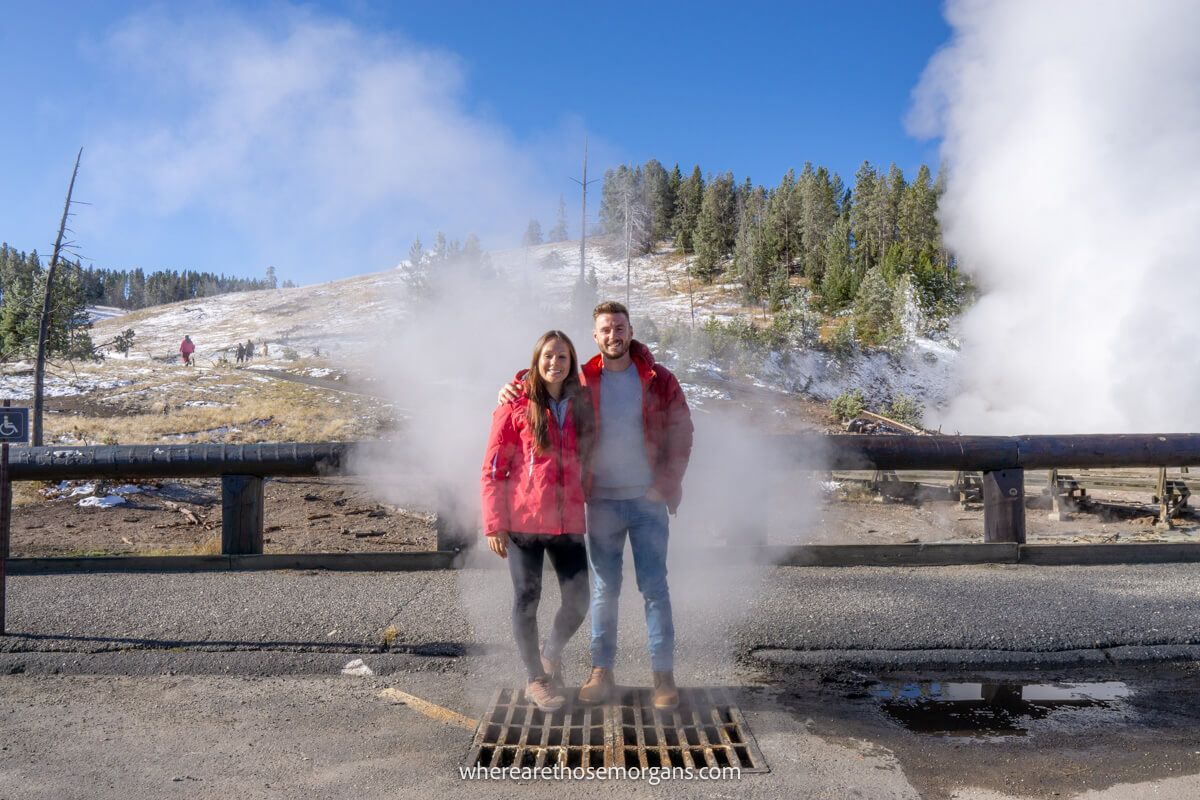
What we liked: The park was calm, quiet and stress free which is why we chose October. We knew this wouldn’t be the case in July or August. Hotels inside the park and nearby had more availability and cheaper prices, and it was possible for us to book last minute which was a big deal. We missed the fall colors but snow on the ground meant we had unique photo opportunities and wildlife was pretty active.
What we didn’t like: We were gutted to miss the fall colors, but worse was the road between Canyon and Tower closing so we couldn’t hike Mt Washburn which was the only trail we really wanted to do. Also, the hot springs and geysers weren’t as clear or vibrant as they might have been. Having to detour through a different entrance was inconvenient but not the end of the world.
Is October a good time to visit Yellowstone National Park? Yes! Visiting Yellowstone in October allows you to experience the park when it’s quieter, cheaper and full of surprises with ever changing weather systems. If you prefer to avoid the crowds when you travel, the fall season is a fantastic time to plan your trip to Yellowstone, as long as you don’t mind absorbing the risks with roads or trails closing. We recommend visiting earlier in the month to negate some of those risks and benefit from fall foliage colors.
We hope our guide to visiting Yellowstone National Park in October helps with planning your fall vacation!
Please let us know if you have any questions in the comments box a little further below.
Happy Travels,
Mark and Kristen
Enjoy this guide? Pin it for later!
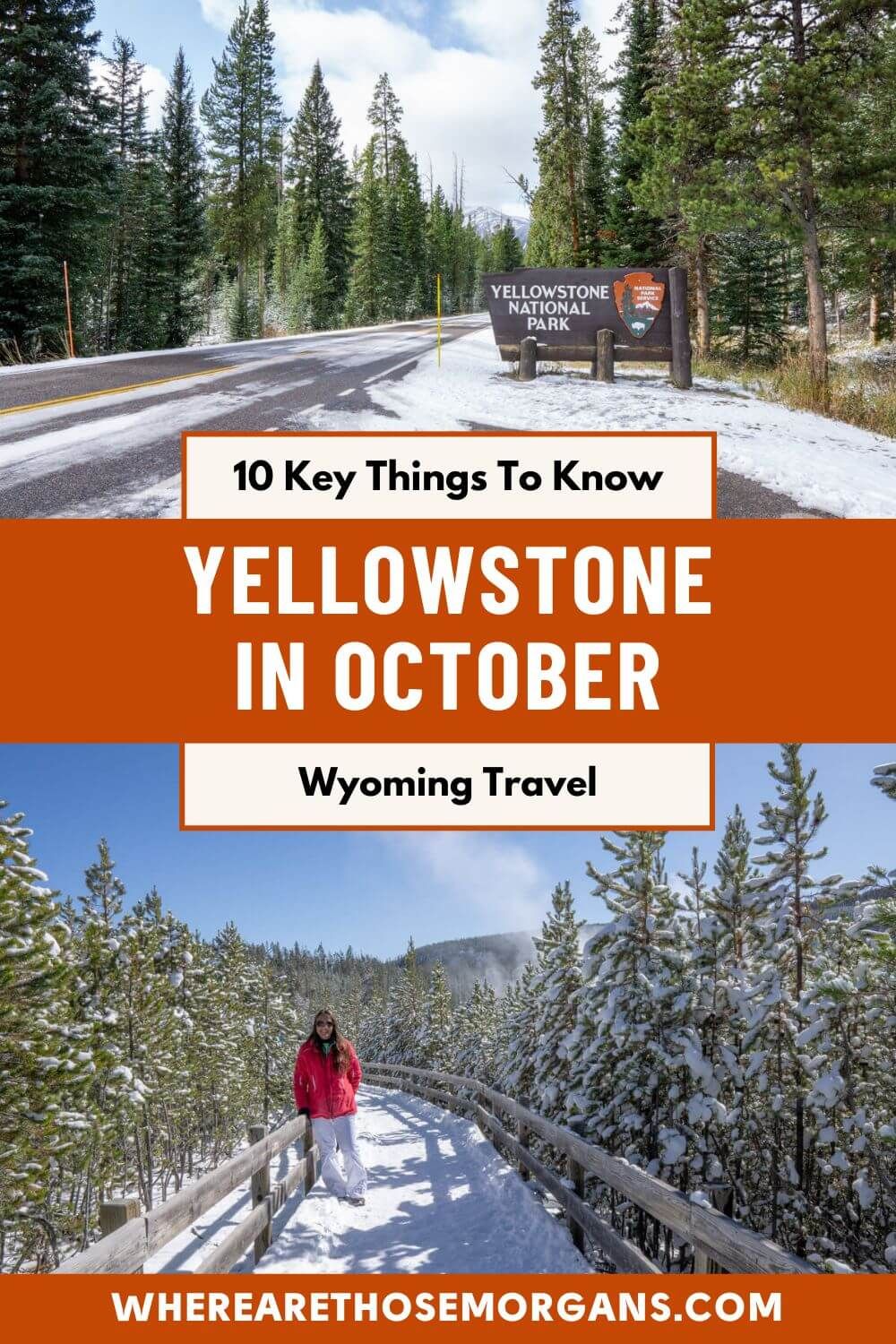
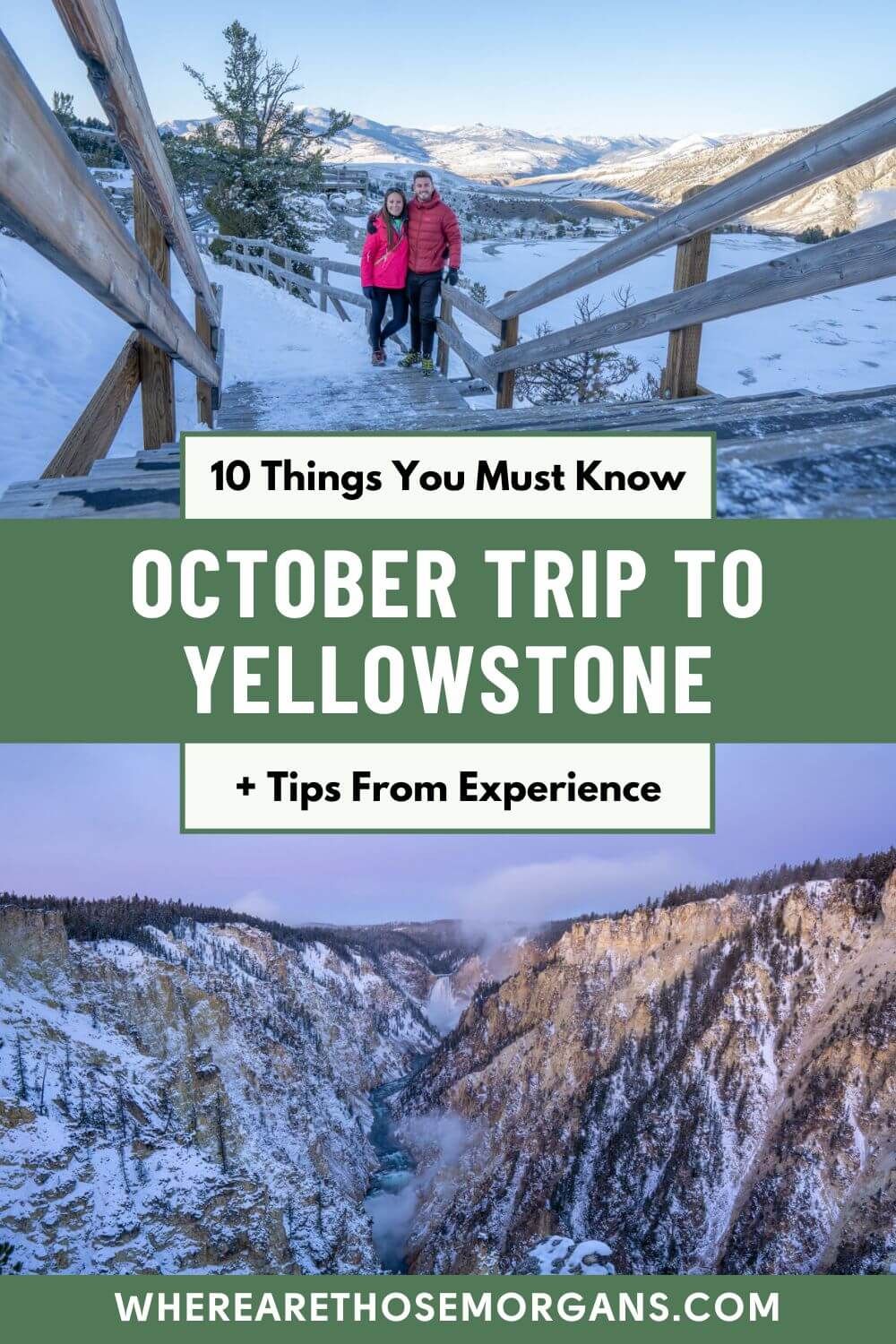
All Rights Reserved © Where Are Those Morgans, LLC. Republishing this article and/or any of its contents (text, photography, maps, graphics, etc.) in whole or in part is strictly prohibited.

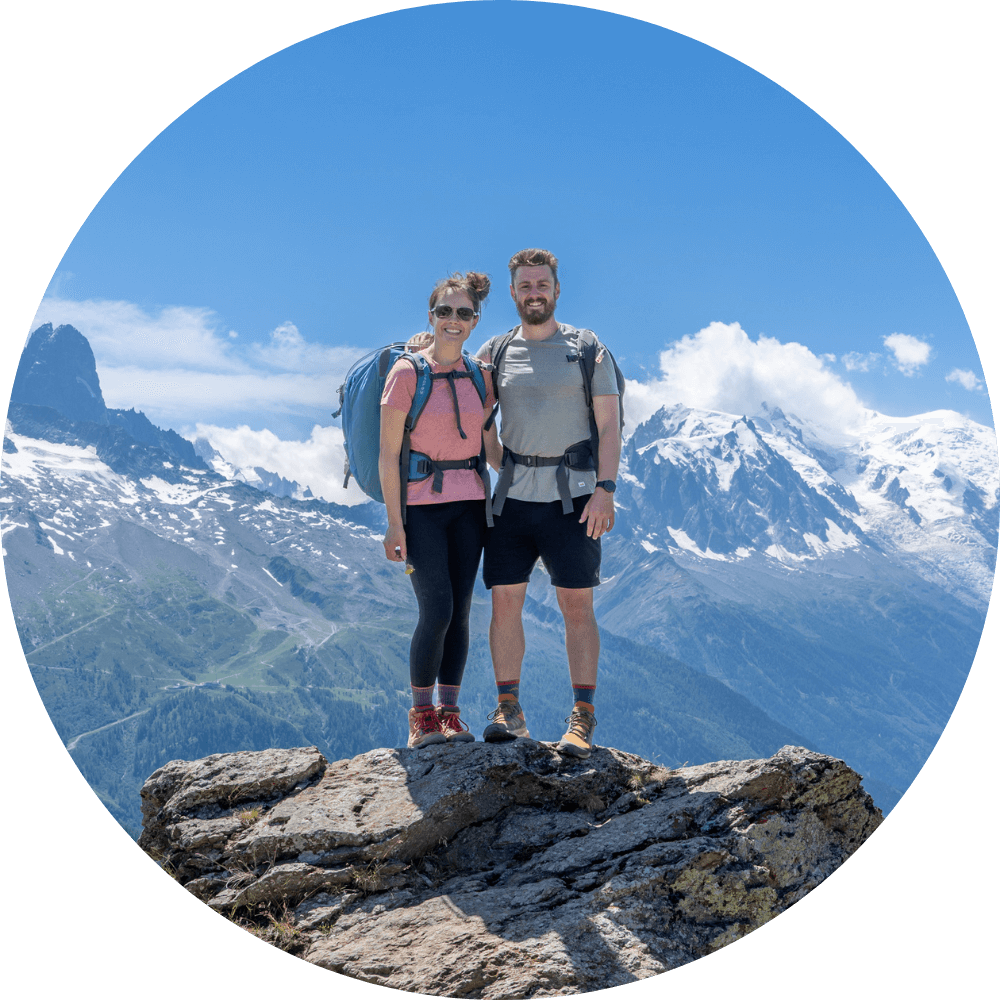
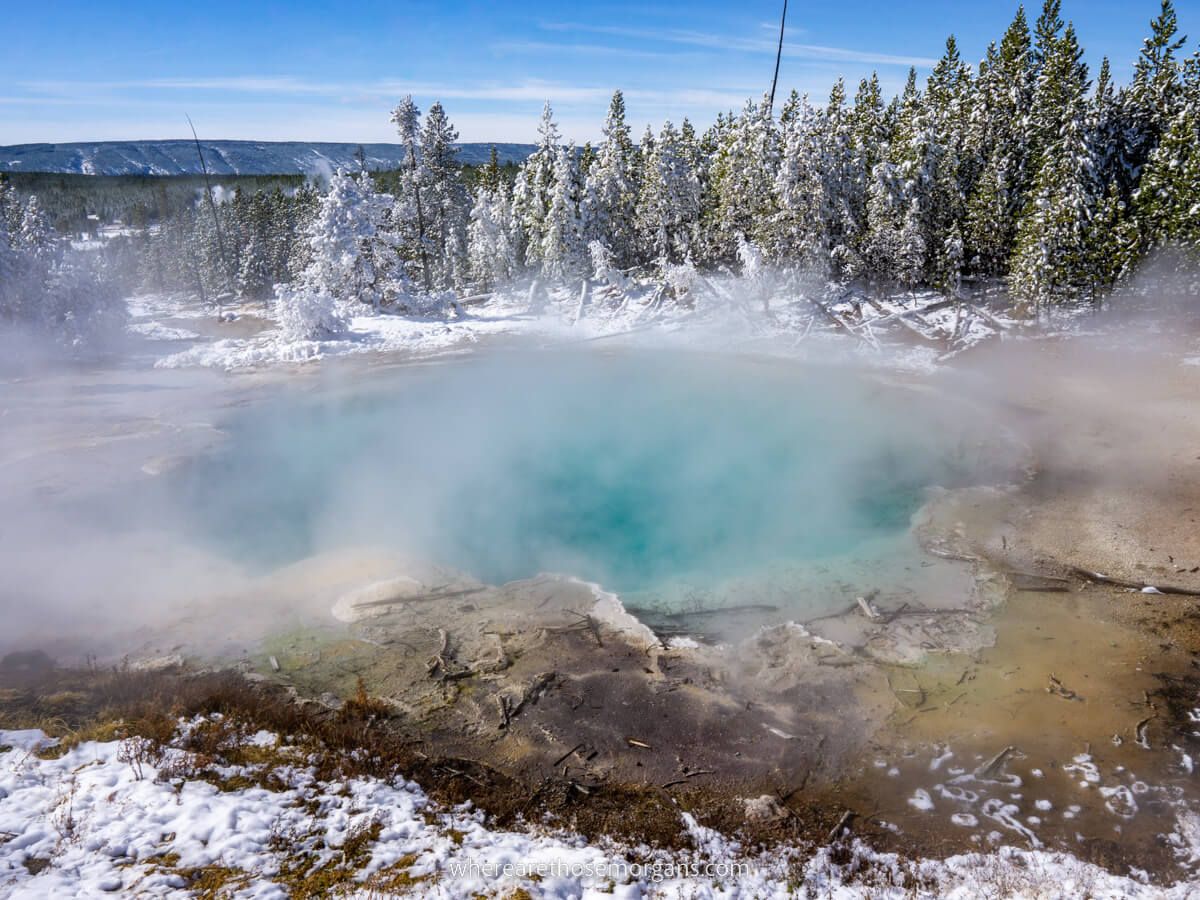
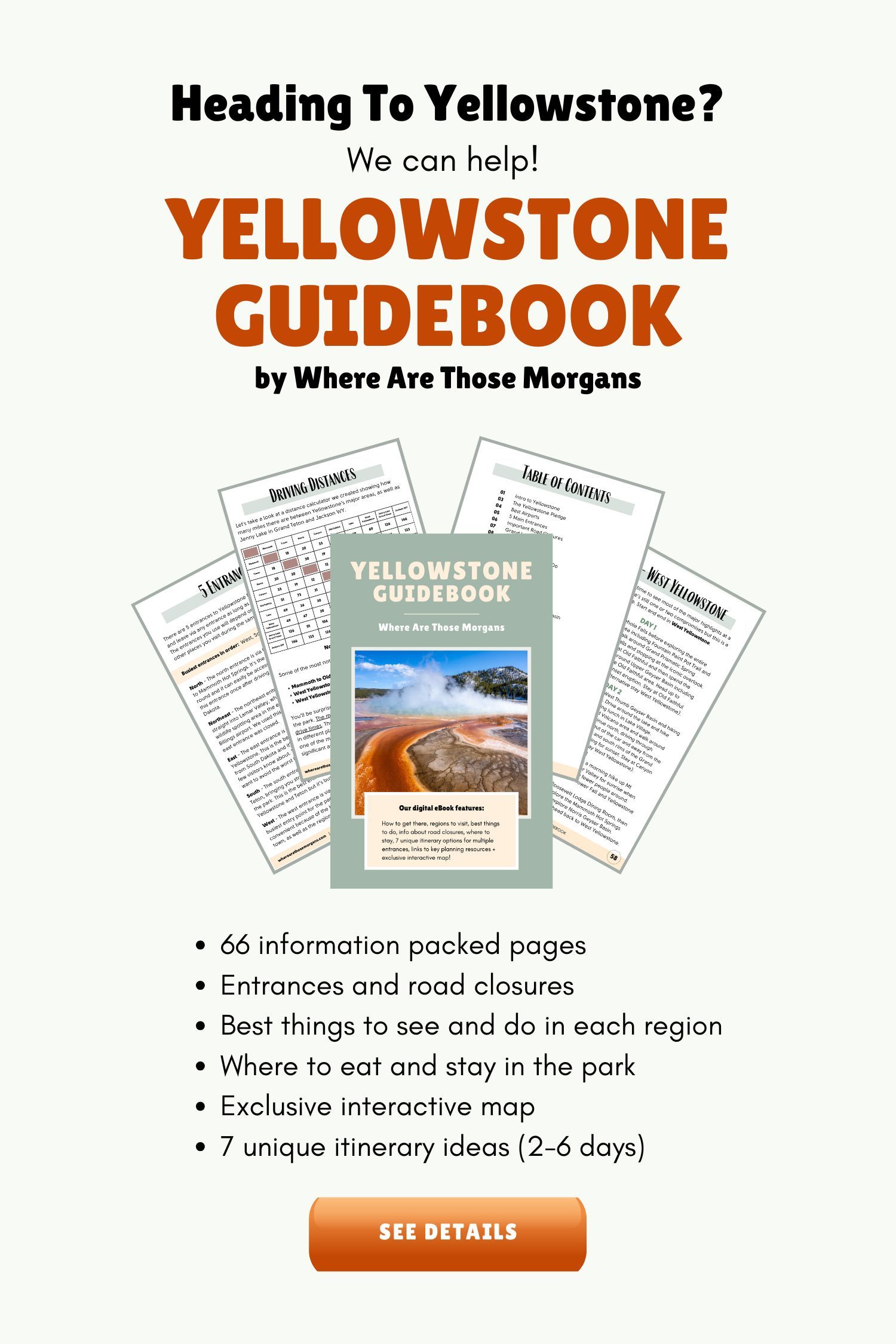
Thank you Mark and Kristen for this article. I eagerly read and saved numerous pages on many different topics. This is the first time we’re going to Yellowstone Park in October, and we are very excited. It’s also the first time that I will experience hiking and all of your advice in preparing to become a hiker is extremely helpful and appreciated. I will be 63 in August and I’m working on weight loss and strength training for healthier new stages of my life. I invested in a Total Gym and I love it. It’s so much fun and safer to use especially when I am recovering from surgeries that fixed problems but also caused weight gain and I am heavier than I’ve ever been. I’m very familiar with the TG as I used one during a very long 6 months of PT after fracturing my back in 2004. It was the best piece of equipment I’ve ever used. I used to go to gyms and used all of the machines and also went to Curves which is fabulous fun. I have lost a lot of weight thus far and I’m going to be ready and willing to enjoy hiking with my husband. He has lost spent that last year getting himself in shape and lost 80# to become healthier and he looks and feels fabulous. He’s back to his military weight and shape. I’m determined to reach my goals a day at a time. It’s also wonder that one of cats loves to walk on a harness and leash so her and I can walk off our winter weight together. Your articles, tips, and incrediable information has given me more motivation and confidence than I have ever had about becoming a hiker. I am very thankful I clicked on your link while surfing Yellowstone Park sites. Keep on enjoying your lives together and sharing all of your wonderful adventures with the rest of the world.
Hi Sharon, we are so happy to hear you have enjoyed reading our guides and you now feel more confident as a hiker! It’s impressive to learn about your weight loss journey (including your husband) and we hope you both come to enjoy hiking together after your visit to Yellowstone. We love hiking because it’s one of the best ways to experience the great outdoors while getting some great exercise. Weather can be a bit unpredictable in October so just be sure to check the weather and road conditions on the official NPS website before visiting the park so you know exactly what to expect. Have a wonderful first visit to Yellowstone!